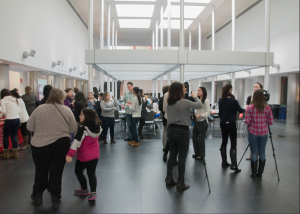Careers in science, technology, engineering and math are on the rise as Forbes and Payscale, a company that acquires real-time information on job market compensations, constantly rank STEM degrees among the highest paying careers for college graduates. However, there continues to be a significant difference between the number of men and women in these fields, as men outnumber their female counterparts.
“There is this mentality that women cannot do well in math and science,” explained Vivian Stojanoff, a physicist and executive board member of Brookhaven Women in Science, who is in charge of organizing speakers for BWIS-sponsored events.
Through a united effort by Stony Brook University’s Women in Science and Engineering program and Brookhaven National Laboratory’s BWIS, Stony Brook University held a symposium centered on getting young women involved in STEM on the eve of International Women’s Day in the Charles B. Wang Center.
This event, the second of its kind, brought together 14 women who varied in profession and involvements in the STEM fields who openly discussed their experiences with an audience heavily comprised of young female students interested in the possibilities of a career in STEM.
 As the panelists spoke about their experiences and took questions from the audience, they encouraged the young women in the crowd to take down the notion that women cannot succeed in STEM, often referring to them as “future colleagues.”
As the panelists spoke about their experiences and took questions from the audience, they encouraged the young women in the crowd to take down the notion that women cannot succeed in STEM, often referring to them as “future colleagues.”
But one of the panelist, Agnes Mocsy, a theoretical nuclear physicist and guest researcher at BNL, also warned the young women about the challenges that has kept the number of women in STEM low, ranging from cultural biases in society to gender stereotypes.
An example Mocsy pointed to was a 2012 study by Dr. Connie Moss-Raucusin at Yale University where STEM professors were asked to judge how competent a student was based on the student’s application, which were all identical except for the single fact that one half were all named John and the other half were all named Jennifer.
The results revealed that both male and female professors had a bias towards the male students over the female students. When it came to salaries, they would offer female applicants an average of about 86 percent of what they offered males.
One of the key elements Moss-Raucusin found, which Mocsy emphasized, was the need for mentors and role models.
“My professors made it so that I never felt disadvantaged by the fact that I was not born a boy,” said Mocsy. “Without them I wouldn’t be here today.”
Most of the panelist agreed that mentors were one of the most important elements in their careers, as a lot of them were introduced and kept on a STEM path by their teachers and professors, but these mentors are also a rarity.
“A lot of these teachers just aren’t grabbing their interests,” said Christine Reilly, who brought six girl scouts from her two troops to the symposium to give them the push she thought they needed.
Reilly encouraged the older girls, a group of tenth graders, to join the networking session at the end of the symposium. Although the girls were reluctant at first, they joined the others as they got to talk one-on-one with the panelist, discussing their future plans and possible internship ideas.
These young women were the ideal demographic targeted by the event coordinators, who stress the importance of getting girls interested during their middle school and high school years in order to avoid what is known as the “Leaky Pipeline.”
According to behavioral scientist Dr. Marci Lobel, a professor at Stony Brook and one of the panelist, the “Leaky Pipeline” illustrates how young women gradually become disenfranchised with fields in STEM throughout their education. A big factor is the lack of encouragement given to girls, which is what the symposium is trying to provide.
“We want to catch them at all parts of the pipeline,” said Kristine Hovat, Stony Brook’s WISE Graduate Assistant and one of the organizers of the event along with Stojanoff.
As the symposium continued passed its allotted time by over two hours, many parents and guardians stuck around to allow the networking session to go on, strengthening the outcome that the organizers were hoping for.
“I want people to realize that they do have a social responsibility to their children, women and girls,” said Stojanoff.
She emphasized a phrase from her native Brazil: “Union makes the force.”




Comments are closed.